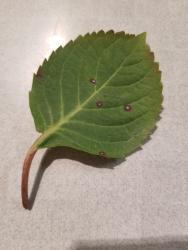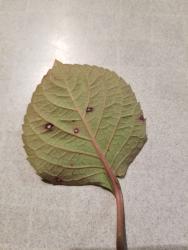This is a fungal disease called Cercospora Leaf Spot. It is caused by the presence of the fungi as well as by overhead watering in the home or in wholesale nurseries/ local plant nurseries.
Chlorothalonil is an approved substance to control cercospora leaf spot so Daconil is the correct fungicide to use to control it. There is no fungicide that cures this disease so fungicides that control it are simply minimizing the chances of large "displays" of leaf spot... In other words, there is no cure so this only helps keep it in check. The only way to "get rid of it" would be to replace the shrub with another uninfected one.
Cercospora usually appears in the Summer months or at the start of Fall. It is actually present at all times as it resides inside the plant but, it becomes "more" visible after the Summer Solstice, when chlorophyll production tapers off and allows the leaf spots to become more visible. The return of rainfall during the late Summer or early Fall period will determine how much leaf spot there will be in this season: more rain, more leaf spot; less rain, less leaf spot.
It usually does not help much to use fungicides (they help control it, not cure it) so, I use good sanitation practices to prevent the spread. Never water the leaves and instead, water the soil early in the morning (6-8am). Dispose of plant debris -the leaves and blooms- of infected plants in the trash (not compost piles) when these fall down or dry out in the Fall. Use drip irrigation or soaker hoses instead of sprinklers. Increase space between plants so the leaves do not touch. Replace the mulch with new mulch in case of large infestations.
Here is more info:
http://www.aces.edu/pubs/docs/...
You can remove the worst of the infected leaves by cutting off the petiole string that connects the leaf to the stem. Do not cut the end of the stem though as this is where invisible flower buds for Spring 2019 develop in the Summer/Fall months... mid-July where you and I live.
Does that help, Terri?
Luis

